PC Format
PC Format was a UK glossy magazine covering Windows hardware and software, including games. The title was also licensed to other countries, and there were sister magazines for Linux. In the 1980s, UK magazines for home computing began to include "covermount" discs, discs full of free and trial software. From its launch in 1991 it had a cover disc- initially a floppy disk, later a CD and then DVD. The print magazine ended in 2015, but still exists on the web.
In 2001, Carlton Video released Space: 1999 on DVD. PC Format #124, July 2001, included Breakaway on the covermount DVD, and included a little feature about it.
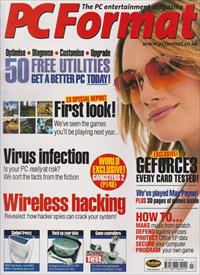
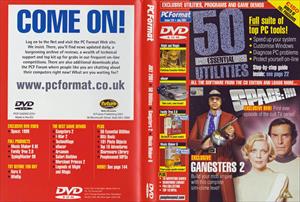

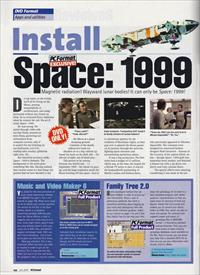
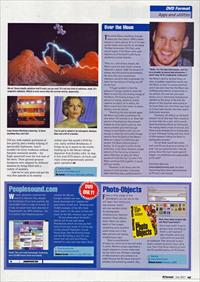
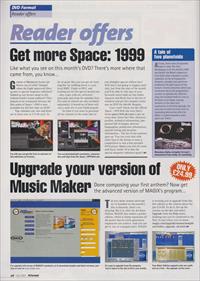
Do you know, in the future, we'll all be living on the Moon, peering meaningfully at oscilloscopes, and using keyboards without any letters on them. Or so reckoned Gerry Anderson when he created the cult 70s sci-fi series Space: 1999.
He was wrong. We sailed through 1999 with our feet firmly planted on terra firma, garnering our information from computer screens, and, if it weren't for the lettering on our keyboards, you'd be reading utter monkey gibberish right now. Ah...
But historical accuracy aside. Space: 1999 is fantastic. The background to the series goes something like this. Having realised that nuclear waste is a bad thing, the powers that be have decided to use the Moon as a giant dumping ground. Canisters of the deadly radioactive trash are chucked on to a big rubbish tip round the back on the dark side - the old out of sight, out of mind ploy.
This proves to be unwise, because one fateful day - 13 September 1999 - the whole lot goes up, and the huge explosion sends the Moon hurtling off into space. And so to adventures aplenty for the residents Of Moonbase Alpha, as they pop over to planets the Moon passes on its journey through the universe, fighting space monsters and encountering mysterious aliens.
It was a big production. The first series had a budget Of £3 million, which was, at the time, the largest for a British TV series to date. It starred the husband/wife partnership of Martin Landau and Barbara Bain, who previously appeared in Mission: Impossible. The costumes were designed by renowned fashion designer Rudi Gernreich - famous as the inventor of the topless bikini, no less - though Space: 1999 garb was somewhat more modest, and featured a bizarre top with a zip down one sleeve and truly colossal flares.
The special effects were amazing, considering it was made in the pre-CGI era, with realistic portrayals of low gravity and a weekly helping of spectacular explosions. And it wouldn't be Gerry Anderson without fantastic miniature models - the Eagle spacecraft were the real stars of the show. These general-purpose transports were adapted for different missions by being fitted with a variety of modules.
And we've only gone and got the very first episode in its entirety etched onto this month's DVD for you. Aptly entitled Breakaway, it brings us up to speed on the events leading up to the Moon's abrupt departure from Earthly orbit. So slap it into your DVD player, sit back, and enjoy some preposterously-plotted space operatics!
Captions:
The whole Moon-travelling-through- space plot that Space: 1999 is based around is clearly absurd. Or is it? To clear up the matter once and for all, we asked The Bad Astronomer. Phil Plait. what would happen if the Moon really were blasted out of the Earth's orbit by an accidental nuclear disaster...
"First, no - with known physics, the Moon could not leave Earth's orbit as depicted in Space: 1999. The amount of energy required would be phenomenal, far more than any conventional explosion would be able to generate. It's more like the amount of energy put off by the Sun!
"A bigger problem is that the amount of energy needed to expel the Moon is more than the binding energy of the Moon. The binding energy is the amount of energy needed to totally vaporise an object. So in reality, the Moon would have been blown to atoms, literally, and not ejected.
"Watching the pilot episode again, the Moon was under acceleration for only about 150 seconds or so. Given the amount of acceleration they showed (maybe six times Earth's gravity), that would probably give them enough energy to leave Earth's orbit, but not enough to leave the Sun's orbit! Escape velocity from the Earth at the Moon's distance is about 1 ES kilometres per second. The Moon orbits at about 1 km/sec. So if you give it a kick of only 0.5km/sec. it will leave. However, escape velocity of the Sun at our distance is about 40km/sec. so really the Moon would still orbit the Sun. So even if the Moon somehow held together, it would still stay nearby.
"However. in the show. over the course of a few episodes, it becomes clear that there was a guiding hand in the Moon's destiny. Several times, an alien of godlike capabilities would stop the Moon, Or alter its course somehow, and it was also clear that the Moon was fulfilling some destiny of some kind. In my opinion, this was not just a plot device. but an interesting metaphysical addition to the show. In the end, the physics of the situation were wrong as we know them, but since there was more to it than mere physics, the show wasn't technically incorrect.
"Ironically, the effects on the Earth wouldn't be all that bad. There would be no more tides for a start, which would have devastating effects on fishing and the mating habits of lots of animals, but there would probably be no earthquakes or such. Although having said that, there is little evidence linking the Moon to earthquakes anyway!
"So the Earth would fare pretty well. and life would go on as normal. I'll note I am just guessing here: I may be wrong. Since this hasn't (and cannot!) happen, my predictions are unproveable, so I'm safe!"
Visit Phil's Web site, www.badastronomy.com, for more fascinating facts about bad astronomy on TV and in the movies! He now blogs on SyFy.com
Like what you see on this month's DVD? There's more where that came from, you know...
Gasped as Moonbase Alpha got blown out of orbit? Jumped when the Eagle spacecraft blew up due to special magnetic radiation? Sobbed as our heroes adapt to life without Earth's warm embrace? Then prepare to be overjoyed, because the first series of Space: 1999 is now available for the first time on DVD!
Yep, volumes one, two and three are in store now at £15.99 each. So far so good. But you can get all three together by toddling down to your local HMV, Virgin or MVC and looking out for the special boxed sets - they come with six collectors' postcards and room for episodes four, five and six (which are also available separately). A boxed set of three will cost a mere 45 of your Earth pounds.
So what if you want to purchase all six volumes at the same time in one almighty special edition box? Well that's not going to happen until July, but from the start of the month you'll be able to visit any of your favourite stores (add on-line dudes Amazon and Black Star to the list of retailers) and get the complete series one on DVD for £84.99. Bargain.
Can't wait? Check out the official Space: 1999 Web site now (that's www.space1999.uk.com) to get an extra dose. Great fact files, character profiles. technical information, jam- packed full or images, director biographies, production information, episode listing and storyline information... The list of site contents goes on. You can even chat with other fans in the forum or enter a competition to win a free portable DVD player. Makes you feel all warm and fuzzy inside. Or is that the special magnetic radiation again? RF
Actually. there were 24 episodes made in total. The first. Breakaway, is on this month's DVD and details the Moon's departure from Earth after a bonkers nuclear explosion. So far so implausible. However, episodes two and three emphasise the dark nature of the human-interest storylines which was to become key to the programme.s success. In episode two, Helena's long-lost husband finds his way to the base on an Eagle, causing tensions in the close-knit community. In the third episode. the crew has to come to terms with its impending destruction after the Moon is sucked towards a scary giant sun. Yikes!
Moonbase Alpha, metaphor for man's detachment from reality. Or something.
Space: 1999 copyright ITV Studios Global Entertainment